‘RAGS TO RICHES’ THE BEDOUINS PROPHECY
A common trope that adherents to hadith like to cling on to, is the idea that the Sunni hadith corpus contains prophecies about future events. One of these prophecies is elaborated on by an article written by one of these hadith-adherents, ‘Proving Islam’. The following will go through these arguments and explain why this prophecy isn’t necessarily a prophecy about the UAE/Saudi Arabia as the author alleges
Vaticinium Ex-eventu Prophecies and The Isnad System
The Vaticinium Ex-eventu is a Latin term to mean ‘prophecies that are formulated after the event’. The concept is simple to understand. Imagine in 2011, Jacob grabbed a piece of paper and wrote ‘there will come a time when the people of Kush will split. The one side will remain steadfast to the rope of GOD, while the latter will revert to the ways of their ancestors and be destined to hell.’ In the year 2011, Jacob is writing this and is intentionally using the name of old kingdoms, Kush (modern Sudan region), in order to depict the prophecy as old. Jacob then fabricates a chain of transmission to give the appearance that he heard this from several generations before him with his grandfather being the one who gave the initial prophecy. Jacob then transmits this prophecy to several other people (who then widely transmits the narration). It looks like the following:
Chain 1 – Max (Jacob’s Grandfather) – Ryan (Jacob’s father) – Jacob – Chris – Jason
Chain 2 – Max (Jacob’s Grandfather) – Ryan (Jacob’s father) – Jacob – Chris – Brian
Chain 3 – Max (Jacob’s Grandfather) – Ryan (Jacob’s father) – Jacob – Payton – Yuji
Chain 4 – Max (Jacob’s Grandfather) – Ryan (Jacob’s father) – Jacob – Sophie – Paul
Chain 5 – Max (Jacob’s Grandfather) – Ryan (Jacob’s father) – Jacob – Reid – Hans
Chain 6 – Max (Jacob’s Grandfather) – Ryan (Jacob’s father) – Jacob – Link – Janet
When Graphed:
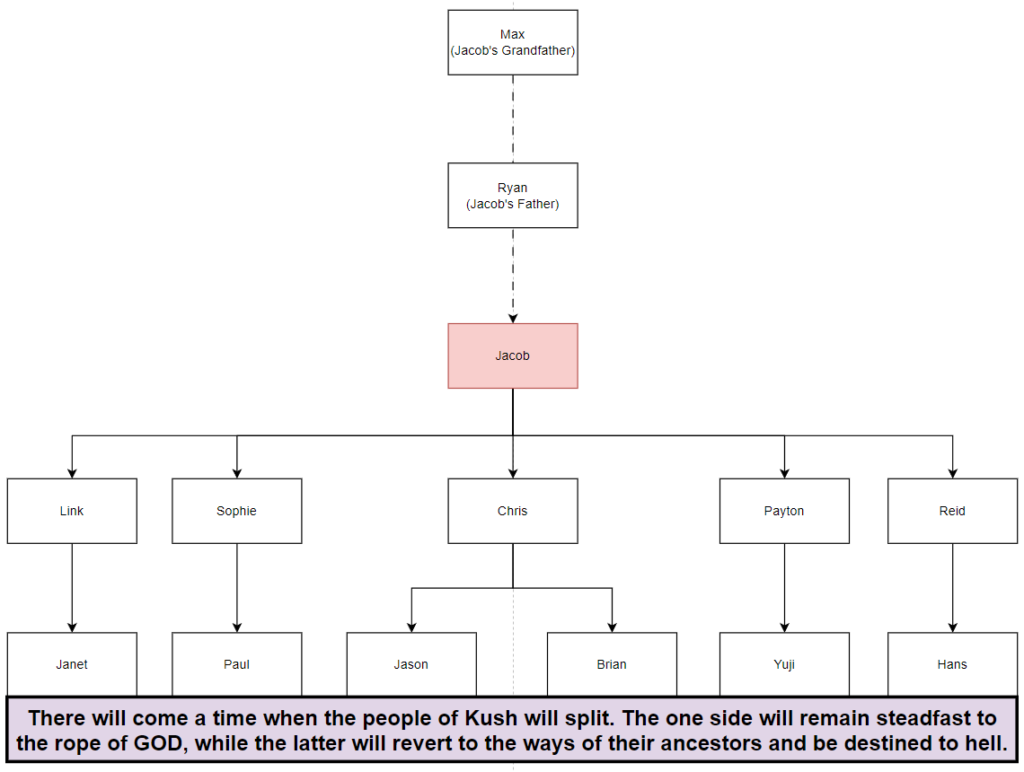
The graph depicted above tells us a visual representation of the chains of transmission in regards to this prophecy. During the time of Janet, Paul, Jason, Brian, Yuji, and Hans, they believe the transmission of the narration dates back to Max (d.1942) and that he predicted the split of the state of Sudan in 2011. The split occurred, with the Northern territory religiously adhering to Islam, and the Southern region mainly adhering to Christianity and other traditional faiths. According to the last generation that received this narration, since Max predicted these narrations in the 1900s and it came true in 2011, the recipients believed that Max accurately prophesied the split of Sudan in 2011. The problem with this, is that Max never made this prophecy and Ryan never received such a tradition. It was all a fabrication of Jacob who lived during the time of Sudan’s split. Jacob then fabricated an isnad (chain of transmission) back to Max to give the allusion that he created this prophecy. Jacob’s ‘prophecy’ was a vaticinium Ex-eventu. He created the prophecy after the event occured, and then fabricated an isnad to give the allusion that Max was the one that predicted it generations before him.
To see a real case study of this, read Joshua Little’s analysis of the Syrian prophecy about the Antichrist here.
The Faulty Logic and Fallacies
Before we get into all of the errors in their thinking and the true reason for this narration’s existence, our apologists have given us their arbitrary four criteria in discerning whether or not a prophecy is legitimate. They are as follows:
- The prophecies must be unintuitive and cannot be expected to happen/easy to predict.
- There needs to be risk to the prophecy, which means it needs to be falsifiable in the sense that it can have the chance of going wrong and be false.
- The prophecy has to be specific and not vague. There can not be various interpretations, meaning there would be no means of allowing reinterpretation of the prophecy to fit any and every situation.
- A true prophet of God is not allowed to get any prophecy incorrectly. Someone receiving divine revelation should not be receiving false prophecies and then attribute them to God. This exposes them as a false prophet.
When it comes to the prophecy of bedouins building tall buildings, let’s see if it reaches all four of these criteria. Criteria 1: The claim is that the prophecy is unintuitive because it predicts that impoverished Bedouins, who were barely surviving, would compete in building tall buildings. This prophecy is not as intuitive as it seems. Throughout history, societies have undergone dramatic transformations due to external factors like resource discovery (e.g., oil), technological advancements, or geopolitical changes. The Bedouins’ transformation in the UAE was driven by the discovery of oil, a random but explainable event. Predicting societal change, especially in a region with significant potential for resource wealth, is not as unlikely as the argument suggests. Additionally, the rise of civilizations from humble beginnings is a recurring theme in history (e.g., the rise of the Mongols or the transformation of medieval Europe). The prophecy’s fulfillment relies on hindsight bias—it only seems remarkable after the fact. The fact that we have barefooted bedouins i.e. Nabateans, who were capable of building structures like that of Petra, Mada’in Saleh, and others, show how any individual could claim that the prophet was aware of such structures do to being a merchant and traveling, and thus made a similar prophecy about his own people after attaining a lot of wealth when he conquered Mecca and expanded his state to include all of Arabia. So in reality, the prophecy was not very intuitive and fails the first criteria.
Criteria 2: The next claim is that the prophecy carries risk because it predicts something improbable—impoverished Bedouins building tall buildings. The prophecy is not truly falsifiable because it lacks specificity about timing, location, or mechanism. It doesn’t say when the Bedouins would build tall buildings, which Bedouins would do so, or how this transformation would occur. Without these details, the prophecy can be applied to any group of Bedouins who experience wealth or modernization at any point in history. For example, if the Bedouins in the UAE had remained poor, the prophecy could have been reinterpreted to apply to another group or time period. This lack of specificity makes the prophecy unfalsifiable and therefore not risky. Not to mention, the hadith that these apologists cite are not all in the same. Some of these variants carry very different prophecies despite referencing the same thing:
The Prophet said, “One of the signs of the Hour is that the shepherds of sheep will compete in constructing tall buildings and that the barefoot, naked, destitute people will become leaders. And that a slave woman will give birth to her mistress and her owner.” (Ahmad 9128 – Sahih)
The Prophet said, “…When the servant girl gives birth to her master, and you see the barefooted, naked, destitute shepherds competing in the construction of tall buildings, that is among its signs…” (Ibn Hibban 159 – Sahih)
The Prophet said, “…When the barefoot and naked become leaders of the people, that is one of its portents. When shepherds compete in constructing buildings, that is one of its portents.” (Ibn Majah 4044)
The variants do not universally agree on the characteristics of who will fulfill this prophecy. In some narrations, it’s the shepherds of sheep, in others it characterizes them as barefooted, naked and destitute shepards. What makes one more valid over the other if they all agree on the highest grading for each of these narrations? On top of this, during the lifetime of the prophet, they had: two – three storied buildings, large mosques were considered tall buildings, a palace was considered a tall building, and the Umayyad period (known for its distinctive and elaborate architecture: see Qubbat Al Sakhra) created many tall buildings prior to the compilation of the hadith corpus.
Criteria 3: The next claim is that the prophecy is specific because it mentions “barefoot, naked Bedouins” competing in building tall buildings. In reality, The prophecy is actually quite vague. It doesn’t specify: Which Bedouins: It doesn’t identify a particular tribe, region, or group. What constitutes “tall buildings”: This is subjective and open to interpretation. Tall buildings have existed for centuries (e.g., pyramids, cathedrals), so the prophecy could be applied to almost any society that constructs large structures. Timing: It doesn’t provide a timeframe for when this would happen. Mechanism: It doesn’t explain how the Bedouins would achieve this transformation (e.g., through oil wealth, technological advancement, or conquest). The vagueness of the prophecy allows it to be reinterpreted and applied to various situations, undermining its specificity. One of the other requirements under this criteria is that it can’t be easily interpretable to fit another circumstance. Ibn Hajr Al-Asqalani states in Fath al-Bari-
تقدم في كتاب الإيمان من وجه آخر عن أبي هريرة في سؤال جبريل عن الإيمان قوله في أشراط الساعة ويتطاول الناس في البنيان ، وهي من العلامات التي وقعت عن قرب في زمن النبوة
Translation: “It has been related previously in the “Book of Faith” through another chain, from Abu Hurairah regarding Gabriel’s question about faith, his saying (Abu Hurairah) regarding the signs of the Hour and the competing in constructing tall buildings: “And this is amongst the signs that happened close to the time of (Muhammad’s) prophethood.””
According to Ibn Hajr, this narration was believed from Abu Hurairah himself (the one relating the prophecy to begin with), that the bedouin prophecy was actually something to have occurred during the time or close to the time of the prophet. This actually makes the closest sense. The Bedouins, who conquered regions outside Arabia, acquired immense wealth, which they could only spend on the construction of buildings, supported by the hadith: “…we have got (so much) wealth that we find no way to spend it except on the construction of buildings” (Sahih al-Bukhari 5672). This suggests that the construction of buildings was a practical response to their newfound wealth, not a fulfillment of a prophecy. After conquering wealthy regions, the Bedouins transitioned from a nomadic lifestyle to one of settled luxury, and building large structures was a natural way to utilize their resources. This historical context undermines the idea that the prophecy was divinely inspired, as it reflects a predictable outcome of conquest and economic change rather than an extraordinary prediction.
Criteria 4: The claim is that the prophecy about the Bedouins is evidence of Muhammad’s divine insight because it came true. The fault about this logic is that it’s just plainly not true. The previous three endeavors into the apologists own criteria ends up exposing this narration as something easily fathomable. It is entirely plausible that the hadith about the Bedouins and bunyān (big buildings) was fabricated or emphasized to discourage people from wasting their wealth on worldly indulgences. In early Islamic society, there was a strong emphasis on modesty, humility, and the avoidance of extravagance. A hadith warning against the misuse of wealth by linking it to the construction of large buildings would align with this moral framework. By framing the construction of buildings as a sign of excess or a distraction from spiritual pursuits, the hadith could have served as a rhetorical tool to promote ethical behavior rather than a genuine prophecy. The argument highlights a critical flaw in the claim that the prophecy has been fulfilled by the construction of skyscrapers in the Gulf. Those building these modern structures are not the same barefoot, semi-naked, and destitute shepherds described in the prophecy. The individuals responsible for the Burj Khalifa or Jeddah Tower are wealthy elites, engineers, and business magnates who have little in common with the impoverished Bedouins of the past. The prophecy specifically refers to the Bedouins themselves, not their descendants or unrelated groups who have risen to wealth through entirely different means. This disconnect between the prophecy’s description and the reality of modern Gulf societies further weakens the claim that the prophecy has been fulfilled. In conclusion, the argument demonstrates that the prophecy is either a historical observation, a fabricated moral lesson, or a misapplied prediction that fails to align with the realities of the modern world.
Bedouins Building Tall Buildings Prophecy
There are some narrations in the canonical hadith books of the Sunni corpus that mention a prophecy about Arabs building tall buildings:
When the Prophet (ﷺ) was asked about the signs of the Final Hour, one of the signs he mentioned was:
“…When shepherds compete in constructing buildings, that is one of its portents…” (Sunan Ibn Majah)
“…When the shepherds of the black (camels) would exult themselves in buildings, then that is from its signs...” (Sahih Muslim)
Tall Buildings Were Known in Pre-Islamic Times
Al-Khazneh – The Nabataeans (4th Century BCE)
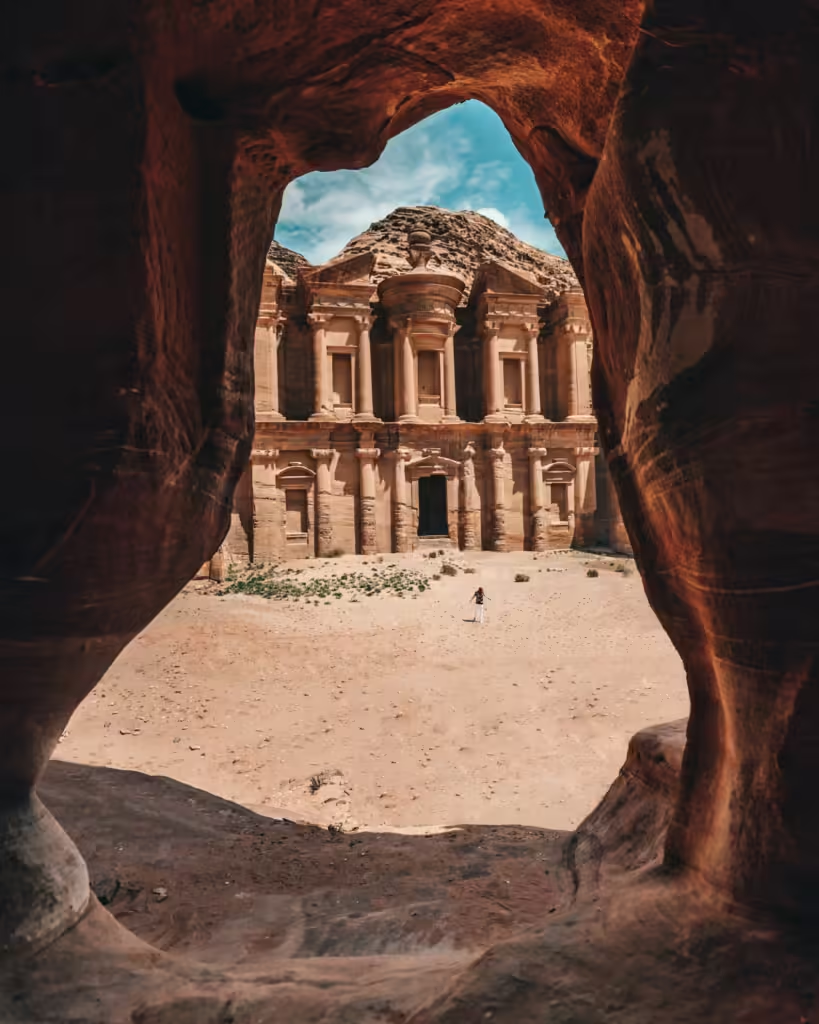
The picture above is known as ‘Al-Khazneh’ located in Petra, Jordan. This site was inhabited by a group known as Nabataeans that resided in the area around the 4th century BCE. The Nabataeans, an Arab nomadic group, leveraged the strategic location of Petra near the incense trade routes, turning it into a prominent regional trading center. Skilled in surviving the harsh desert, they effectively used the area’s mountainous landscape to ward off invasions. The city of Petra thrived in the 1st century AD, a period marked by the erection of the Al-Khazneh structure, thought to be the mausoleum of King Aretas IV of the Nabataeans, and a population boom to an estimated 20,000 people. To survive in the dry desert conditions, the Nabataeans built a sophisticated system for collecting and storing rainwater, comprising cisterns, channels, and dams. Most of the well-known structures carved into rock, which are mostly tombs, were constructed during this time and the subsequent period. In contrast, fewer of the city’s standalone buildings have been preserved.
This is an example of Bedouin Arabs building tall structures that defy the popular conception of what Bedouin Arabs are capable of. This structure predates Muhammad and the believers by a couple centuries. This is just some evidence to suggest that tall buildings were not foreign to Bedouin Arabs who traveled all throughout Arab lands.
Al-Hijr – The Nabataeans (1 BCE to 1 CE)
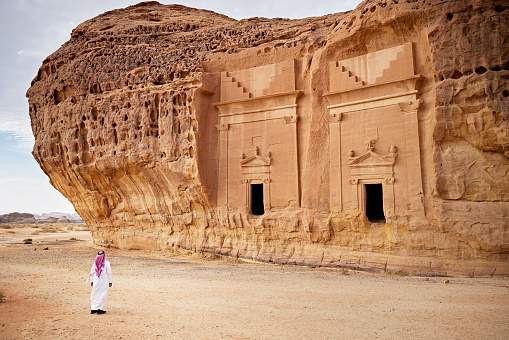
The picture above is known as ”Al-Hijr“. This is another example of the Nabataeans (Bedouin Arabs) building tall structures prior to the advent of Islam, and the Prophet Muhammad. Al-Hijr is located approximately 460 miles from Mecca, Saudi Arabia and is directly mentioned in the Quran (Surah 15).
Al-Hijr, also referred to as Mada’in Salih or Hegra, is an archaeological site from the pre-Islamic era situated in the Al-‘Ula region within the Medina Province of Saudi Arabia’s Hejaz region. The site is renowned for its tombs carved from rock and other structures, which were constructed by the Nabateans from the first century BC to the first century AD.
Sources From the Tradition
The Summer and Winter Caravans
The Quran states:
[106:1] This should be cherished by Quraish.
[106:2] The way they cherish the caravans of the winter and the summer.
[106:3] They shall worship the Lord of this shrine.
[106:4] For He is the One who fed them after hunger, and provided them with security after fear.
If we look to the traditional account of such caravans, Ibn Ishaq-Ibn Hisham recount the specifics of these caravans:
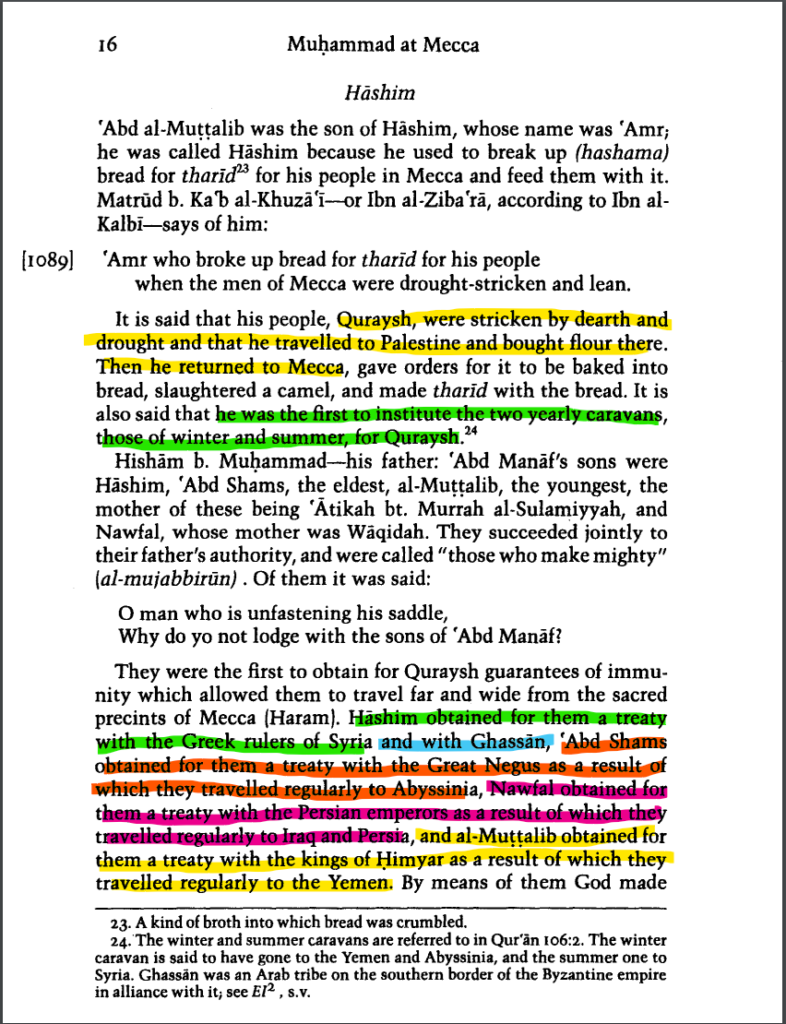
The History of al-Tabari Vol. 6: Muhammad at Mecca, pg. 16
Prior to the birth of the Prophet, Hashim and other prominent Quraish leaders managed to gain treaties with those of foreign lands with the purpose of trading. This would mean the inter-mingling with Quraishi traders and the traders of foreign lands. Hashim received a treaty of the Eastern Roman Empire, and with the Ghassanid Empire. Abd Shams obtained a treaty with Ethiopia. Nawfal obtained a treaty with the Persian Empire. Al-Muttalib obtained a treaty with Yemen.
Outlining the different civilizations with which the Quraish and Bedouin Arab tribes were in contact allows us to see the civilizational structures that these people built. Tall buildings and structures were not foreign to the Bedouins, but rather, they were once building such structures (as mentioned with Al-Hijr and Al-Khazneh). Lets see examples of tall/complex structures that foreign civilizations built that these Bedouin Arabs had contact with through these caravans.
The Eastern Roman Empire (Byzantium)
The Temple of Jupiter (Optimus Maximus) – 509 BCE

The Temple of Jupiter Optimus Maximus, also known as the Temple of Jupiter Capitolinus, was a significant structure in Ancient Rome, situated on the Capitoline Hill. It was traditionally dedicated in 509 BC and was the oldest large temple in Rome. The first building was made of wood and was destroyed by fire in 83 BC. The reconstruction of the temple involved craftsmen from Greece, and the new building was essentially Greek in style, but retained many elements of Etruscan form. The second version of the temple was completed in 69 BC.
Over the centuries, the temple was reconstructed twice more due to fires. The subsequent temples followed the contemporary Roman architectural style, but were of exceptional size. The first version is the largest Etruscan-style temple recorded, and much larger than other Roman temples for centuries after. However, its size remains heavily disputed by specialists.
The reconstructions usually show very wide eaves, and a wide colonnade stretching down the sides. A crude image on a coin of 78 BC shows only four columns, and a very busy roofline. With two further fires, the third temple only lasted five years, to 80 AD, but the fourth survived until the fall of the empire.
Ethiopia
The Great Temple of Yeha (Axumite Kingdom) – 700 BCE

The Yeha Temple, also known as the Great Temple of Yeha, is believed to be the oldest standing structure in Ethiopia12. It was built around 700 BC during the reign of the D’mt, a pre-Aksumite kingdom. The builders of the Yeha Temple were part of the Da’amat people, who ruled the area during the temple’s construction. The temple is located in the Tigray region of northern Ethiopia and is a significant archaeological site. A remarkable aspect of the Yeha Temple is that it was constructed without the use of mortar. The temple was repurposed in the 6th century CE as a Christian church and St Abuna Aftse monastery, which could explain its preservation. Other places of interest at Yeha include a burial ground and ruined buildings containing, amongst other things, some interesting square columns.
The Persian Empire
The Pasargadae – 6th Century CE

Pasargadae was an ancient city in Iran, founded by Cyrus the Great, the founder of the Achaemenid Empire, in the 6th century BCE. It served as the first capital of the Achaemenid Empire and held significant historical and cultural importance. The city’s most famous structure is the Tomb of Cyrus, which dates back to approximately 530 BCE. The tomb is a simple yet imposing structure built on a stepped platform, housing the remains of Cyrus the Great. Pasargadae was not only a political and administrative center but also a symbol of Cyrus’s vision of tolerance and multiculturalism, as evidenced by its diverse architectural influences and the incorporation of various cultural elements. The city’s strategic location at the crossroads of trade routes facilitated its growth and prosperity during the Achaemenid period. Pasargadae’s significance endured even after the capital was moved to Persepolis, and it remains an important archaeological site, attracting visitors interested in exploring the ancient history of Iran.
Old Structures & Bedouin Structures
So far, we’ve seen how Bedouin Arabs not only built some of the most impressive structures of their time (Al-Khazneh and Al-Hijr), but they were also in contact with several civilizations that had many of their own complex and impressive structures. We even have accounts from traditional sources claiming that the Prophet traveled to distant lands for trading purposes, an indication that he himself witnessed such structures.

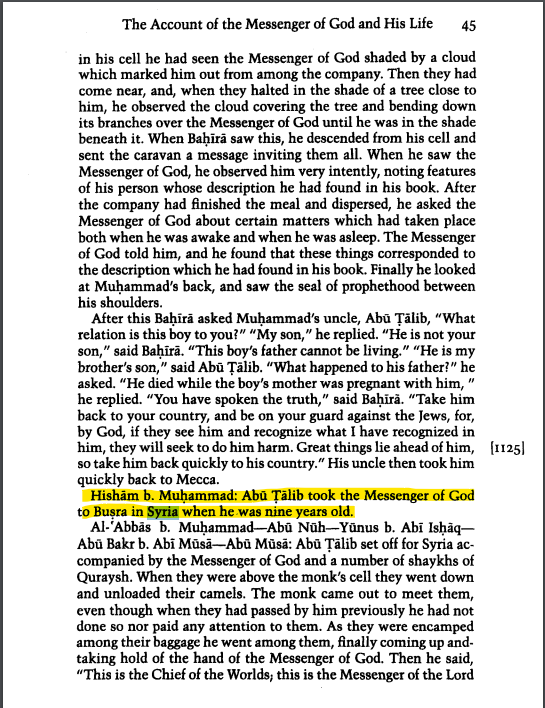
The History of al-Tabari Vol. 6: Muhammad at Mecca p. 44 & 45
Bedouin Structures Immediately After the Prophet’s Death
Not only have Bedouin Arabs built tall structures, but they witnessed them, and traveled to them. After the Prophet’s death, the Emir’s were engaging in wars with surrounding empires, ordering the construction of elaborate structures, and trying to keep the empire together. Just 53 years after the Prophet’s death, we have Caliph Abd Al-Malik b. Marwan ordering the construction of the Dome of the Rock, with Emir Umar b. Al-Khattab building his masjid (5 years after the Prophet’s death, 637 CE).
Ibn Hajar analyzes these narrations and claimed:
قوله ( وحتى يتطاول الناس في البنيان ) تقدم في كتاب الإيمان من وجه آخر عن أبي هريرة في سؤال جبريل عن الإيمان قوله في أشراط الساعة ويتطاول الناس في البنيان ، وهي من العلامات التي وقعت عن قرب في زمن النبوة ، ومعنى التطاول في البنيان أن كلا ممن كان يبني بيتا يريد أن يكون ارتفاعه أعلى من ارتفاع الآخر ، ويحتمل أن يكون المراد المباهاة به في الزينة والزخرفة أو أعم من ذلك ، وقد وجد الكثير من ذلك وهو في ازدياد .
His saying (and until people go to great heights) was presented in the Book of Faith from another perspective on the authority of Abu Hurairah in asking Gabriel about faith. His saying is in the signs of the Hour and people go to great heights, and this is amongst the signs that happened close to the time of prophethood., and the meaning of the ominous in building is that each of those who He was building a house whose height he wanted to be higher than the height of the other, and it is possible that the intention was to show off it in terms of adornment and decoration or more general than that, and he found a lot of that and it is increasing.
Even ibn the explanation given by Ibn Hajar Asaqlani, this ‘prophecy’ wasn’t meant for later generations 1400+ years later. In his view, this was something that had already occurred.
Isnad Analysis


Summary
The prophecy of Bedouins/shepherds building tall buildings is an Iraqi (Kufan and Basran) fabrication and was posited back to the Prophet to make it seem like a legitimate prophecy, similar to the early example with Jacob.
We have examples from before the Prophet of Bedouins building tall buildings (Nabateans, Thamud) as well as Bedouins having access to such archaic structures (Roman territories, Ethiopia, Persia, Yemen, etc.) Even when we look to Sunni commentaries, it was made clear by Ibn Hajar that this ‘prophecy’ was interpreted as something to happen during the time of the Prophet, not in the future.
Muslims in the modern-age like to make the prophecy about today’s age (UAE building tall building, Saudi Arabia building tall buildings, etc.) but this isn’t a reliable comparison. These Arabs are aware of this prophecy, and are now fulfilling the ‘prophecy’ after already knowing of its existence. This would make it a self-fulfilling prophecy. This prophecy was a fabrication made by Iraqi’s in order to give reliance on the hadith corpus. The frabicators were: Yahya b. Ya’mur & Abu Zar’ah
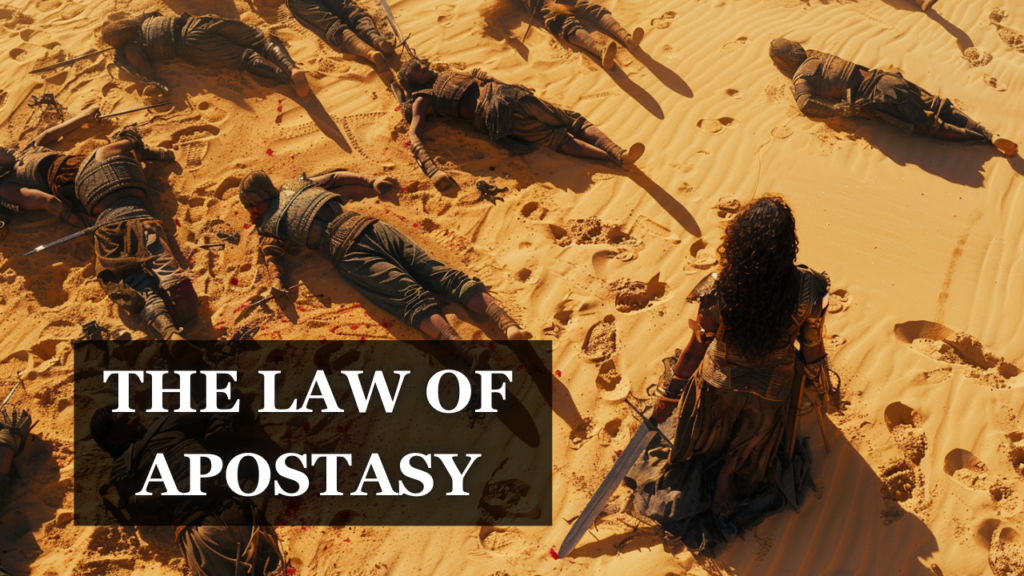
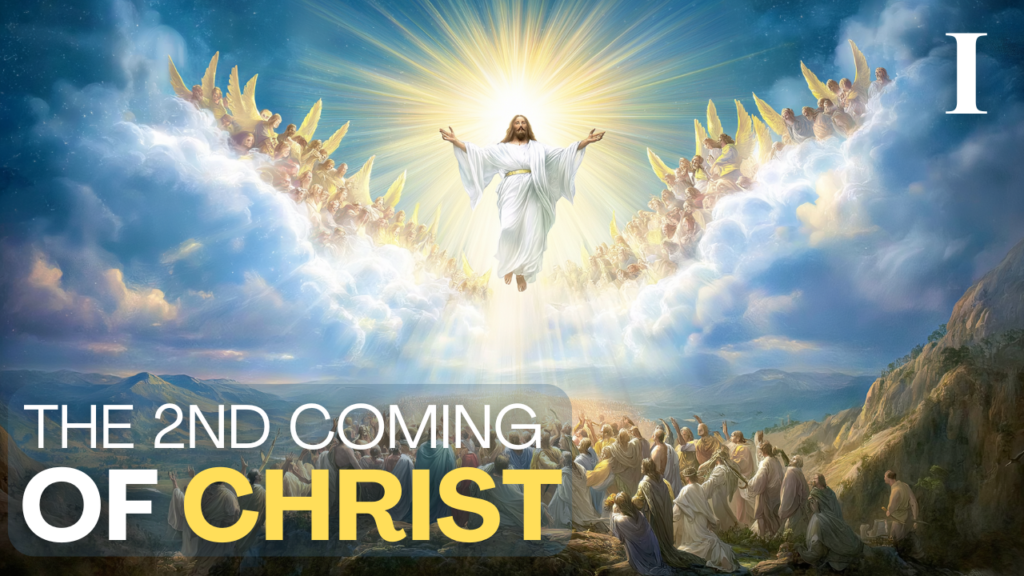
The bedouins who ended up conquering outside Arabia acquired so much wealth, which they couldn’t use for themselves except through construction of buildings, as mentioned in the below hadith.
“…we have got (so much) wealth that we find no way to spend it except on the construction of buildings”.
https://sunnah.com/bukhari:5672
It is possible that the hadith of “bedouin & bunyān (big buildings)” was fabricated in order to discourage people from wasting their wealth in worldly indulgences.
In any case, those building skyscrapers in the Gulf are not shepherds who are bare-footed, semi-naked and destitute.
Pingback: Fabricated Hadith Prophecy: The Fire From Hijaz & The Eruption of 641 AD - hadithcriticblog.com